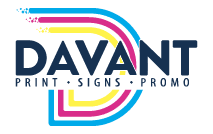Photo Credit: https://unsplash.com/photos/Hcfwew744z4
Your hard work has paid off! Your project is finally complete and ready to be sent off to the printer. But will it print the way you envisioned it? Will the fonts and colors match? Will the images be blurry? These are normal questions for anyone getting ready to print a new project. We here at Davant know how important a quality printing job is, so we’ve compiled a list of tips and tricks to ensure your project is “print ready” and will come out looking exactly how you envisioned it!
File Format
The most important step in getting your project ready for print is making sure the files are in the correct format so that the printer can read them. The most common file format for printing projects is a PDF, or Portable Document Format. This type of file is pretty basic and should be readable by any printer.
There are different ways to convert files to PDFs depending on what program you’re using. Programs such as Microsoft Word or Google Docs have file converters built into their systems: simply click File > Save As and then select PDF from the drop down list. This will allow the program to save the file to your computer in PDF format.
If you’re not sure how to convert your file in the program you’re using, a quick Google search should give you some instructions. Free file converters exist online, but we don’t recommend using them as they don’t always convert files properly and can sometimes cause files to become corrupted.
Embed Fonts
Saving your file as a PDF won’t guarantee that your font comes out the way you want it to look. Not all computers, programs, or printers have the same fonts installed, which can cause problems when sending files off to print. If you want to make sure your font choice is preserved, you need to embed the font into the file. This will ensure that the actual font stays with the project and not just the text.
Microsoft Word also has a built-in program for this: simply click File > Options > Save and then choose “embed fonts in the file.” A quick Google search will yield instructions for other programs if you’re not using Word.
Convert RGB Images to CMYK Colors
When computers generate images, they do so using RGB colors (red, green, blue). These colors allow for higher image quality when viewed on a computer. However, printers use CMYK colors (cyan, magenta, yellow, and black). This is because images print on paper in higher quality using CMYK colors rather than RGB. When you send your project off to the printer, you want to make sure all images are in CMYK to guarantee the best printing job. Doing so can save you a lot of money on costly color correction!
Image Resolution is 300 DPI or Higher
The resolution of images between computers and printers differs in the same way that colors do. Image resolution can be defined as how much data is in a digital image, which directly correlates to how many pixels there are.
Most images that appear on your computer screen are 72 DPI, as this looks better on computer screens and is much easier for the computer to store the files. However, images with such low DPI will print out terribly. To guarantee non-blurry, high-quality images when sending your project to the printer, make sure all images have a resolution of 300 DPI or higher.
Adequate Room for Bleed
“Bleed” is a printing term that refers to images extending beyond the edge of the sheet after trimming. Bleeds are crucial to a high-quality printing job because they affect the design, file specification, and even the cost. If you don’t have a white border around the edge of your project, then your project has a bleed.
Before sending your project to the printer, you need to set the size for your bleed according to the trim. Generally, the bleed should be a quarter of an inch larger than the trim size and 0.125 inches on all sides. These specifications allow for any variations in printing and cutting.
Timing is Critical
Printers all have turnaround times, and it is critical to be aware of those in order to adequately time the printing of your project. You want to make sure you can get your project into the printer’s hands-on time to account for printing turnaround.
If you miss your deadline, your project may not be printed for days or even weeks, depending upon the printer’s availability. To be safe, we also suggest you plan enough time for the printer to print your project twice, in case there are any errors. Planning can protect you from panicking about the deadline and is crucial in getting your project printed on time.
What Next?
Once your project is finalized and print-ready, we here at Davant are prepared to bring your project to life. We believe in the power of print and its unique ability to trigger a variety of senses, from the feel of the paper to the smell of the ink. Print is alive because of its potential to morph into anything your mind can imagine. People will always remember a printed piece because of how it draws attention to itself.
Davant offers printing services to help you reach your audience, inform them, and build a bond between the two. Our experienced team is available to assist you through the entire printing process. Our state-of-the-art equipment allows us to provide our clients with high-quality prints on time and on budget. Whether you’re looking for digital printing, offset printing, or large format printing, at Davant we have the equipment, capabilities, and the know-how to fill all of your printing needs. To find out more about our printing services, visit our website!

